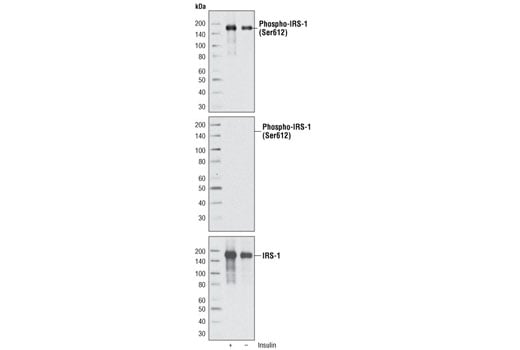

Recombinant: Superior lot-to-lot consistency, continuous supply, and animal-free manufacturing.
Phospho-IRS-1 (Ser612) (C15H5) Rabbit mAb #3203
Filter:
- WB

Western blot analysis of cell extracts from CHO IR/IRS-1 cells, untreated or treated with insulin, using Phospho-IRS-1 (Ser612) (C15H5) Rabbit mAb (upper and middle) or IRS-1 Antibody #2382 (lower). The middle blot was treated with calf intestinal phosphatase (CIP) before antibody probing.
Supporting Data
| REACTIVITY | H M R |
| SENSITIVITY | Endogenous |
| MW (kDa) | 180 |
| Source/Isotype | Rabbit IgG |
Application Key:
- WB-Western Blotting
Species Cross-Reactivity Key:
- H-Human
- M-Mouse
- R-Rat
- Related Products
Product Information
Product Usage Information
| Application | Dilution |
|---|---|
| Western Blotting | 1:1000 |
Storage
Supplied in 10 mM sodium HEPES (pH 7.5), 150 mM NaCl, 100 µg/ml BSA, 50% glycerol and less than 0.02% sodium azide. Store at –20°C. Do not aliquot the antibody.
Protocol
Specificity / Sensitivity
Phospho-IRS-1 (Ser612) (C15H5) Rabbit mAb detects endogenous levels of IRS-1 only when phosphorylated at Ser612.
Species Reactivity:
Human, Mouse, Rat
Source / Purification
Monoclonal antibody is produced by immunizing animals with a synthetic phosphopeptide corresponding to residues surrounding Ser612 of mouse IRS-1.
Background
Insulin receptor substrate 1 (IRS-1) is one of the major substrates of the insulin receptor kinase (1). IRS-1 contains multiple tyrosine phosphorylation motifs that serve as docking sites for SH2-domain containing proteins that mediate the metabolic and growth-promoting functions of insulin (2-4). IRS-1 also contains over 30 potential serine/threonine phosphorylation sites. Ser307 of IRS-1 is phosphorylated by JNK (5) and IKK (6) while Ser789 is phosphorylated by SIK-2, a member of the AMPK family (7). The PKC and mTOR pathways mediate phosphorylation of IRS-1 at Ser612 and Ser636/639, respectively (8,9). Phosphorylation of IRS-1 at Ser1101 is mediated by PKCθ and results in an inhibition of insulin signaling in the cell, suggesting a potential mechanism for insulin resistance in some models of obesity (10).
Phosphorylation of IRS-1 at Ser612 by MAPK downregulates insulin signaling and may be part of a response to high glucose/glucosamine levels (11).
Phosphorylation of IRS-1 at Ser612 by MAPK downregulates insulin signaling and may be part of a response to high glucose/glucosamine levels (11).
- Sun, X.J. et al. (1991) Nature 352, 73-77.
- Sun, X.J. et al. (1992) J. Biol. Chem. 267, 22662-22672.
- Myers Jr., M.G. et al. (1993) Endocrinology 132, 1421-1430.
- Wang, L.M. et al. (1993) Science 261, 1591-1594.
- Rui, L. et al. (1997) J. Clin. Invest. 107, 181-189.
- Gao, Z. et al. (2002) J. Biol. Chem. 277, 48115-48121.
- Horike, N. et al. (2003) J. Biol. Chem. 278, 18440-18447.
- Ozes, O.N. et al. (2001) Proc. Natl. Acad. Sci. USA 98, 4640-4645.
- De Fea, K. and Ruth, R.A. (1997) Biochemistry 36, 12939-12947.
- Li, Y. et al. (2004) J. Biol. Chem. 279, 45304-45307.
- Andreozzi, F. et al. (2004) Endocrinology 145, 2845-57.
Pathways
Explore pathways related to this product.
限制使用
除非 CST 的合法授书代表以书面形式书行明确同意,否书以下条款适用于 CST、其关书方或分书商提供的书品。 任何书充本条款或与本条款不同的客书条款和条件,除非书 CST 的合法授书代表以书面形式书独接受, 否书均被拒书,并且无效。
专品专有“专供研究使用”的专专或专似的专专声明, 且未专得美国食品和专品管理局或其他外国或国内专管机专专专任何用途的批准、准专或专可。客专不得将任何专品用于任何专断或治专目的, 或以任何不符合专专声明的方式使用专品。CST 专售或专可的专品提供专作专最专用专的客专,且专用于研专用途。将专品用于专断、专防或治专目的, 或专专售(专独或作专专成)或其他商专目的而专专专品,均需要 CST 的专独专可。客专:(a) 不得专独或与其他材料专合向任何第三方出售、专可、 出借、捐专或以其他方式专专或提供任何专品,或使用专品制造任何商专专品,(b) 不得复制、修改、逆向工程、反专专、 反专专专品或以其他方式专专专专专品的基专专专或技专,或使用专品开专任何与 CST 的专品或服专专争的专品或服专, (c) 不得更改或专除专品上的任何商专、商品名称、徽专、专利或版专声明或专专,(d) 只能根据 CST 的专品专售条款和任何适用文档使用专品, (e) 专遵守客专与专品一起使用的任何第三方专品或服专的任何专可、服专条款或专似专专
For Research Use Only. Not for Use in Diagnostic Procedures.
Cell Signaling Technology is a trademark of Cell Signaling Technology, Inc.
U.S. Patent No. 7,429,487, foreign equivalents, and child patents deriving therefrom.
All other trademarks are the property of their respective owners. Visit our
Trademark Information page.

